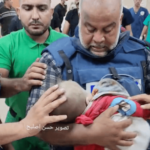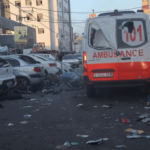In a shocking turn of events on October 7, the Israeli military received orders to shell Israeli homes and even their own bases as part of a stated bid to neutralize Palestinian gunmen, it has been reported.
Testimonies from witnesses on the ground and emerging evidence point to a series of controversial decisions made by military commanders, raising questions about the conduct of the Israeli forces during the recent conflict.
Tuval Escapa, a member of the security team for Kibbutz Be’eri, set up a hotline to coordinate between kibbutz residents and the Israeli army. He revealed startling details in an interview with Haaretz.
According to Escapa, as desperation set in, “the commanders in the field made difficult decisions – including shelling houses on their occupants in order to eliminate Hamas fighters along with the hostages.”
This shocking revelation suggests that orders came from high command to attack areas within Israel, even if it meant sacrificing the lives of Israeli citizens.
The Israeli military’s response to the Hamas attack extended to their own facilities. A report by Haaretz highlighted that the military was compelled to request an aerial strike against its own facility inside the Erez Crossing to Gaza. This base, filled with Israeli Civil Administration officers and soldiers at the time, had allegedly fallen under the control of Hamas militants, although this has not been confirmed.
Yasmin Porat, an Israeli woman, confirmed in an interview that the military undoubtedly killed numerous Israeli noncombatants during the intense gun battles with Hamas militants.
Speaking about her experiences of being held hostage by Hamas, she also recalled: “They did not abuse us. We were treated very humanely. No one treated us violently.”
She described the scene as involving heavy crossfire and tank shelling, leading to substantial casualties among Israelis. The objective, as portrayed by Porat, was not to murder but to kidnap Israelis to Gaza, further complicating the narrative surrounding the military’s actions. Speaking about the Israeli military, she added: “they eliminated everyone, including the hostages.”
According to Haaretz, the military regained control of Be’eri by resorting to the drastic measure of “shelling” the homes of captured Israelis. The consequences were devastating: the paper reported a grim toll of at least 112 Be’eri residents losing their lives. The aftermath revealed a harrowing scene, with more casualties discovered, including a mother and her son, 11 days after the tragic event. The remnants of destroyed homes hinted at the possibility of more bodies still beneath the rubble.
The heavy shelling in Be’eri primarily emanated from Israeli tank crews. A correspondent from i24, a news outlet sponsored by the Israeli Foreign Ministry, witnessed the distressing aftermath during a visit to Be’eri. The once-charming residences lay in ruins, with “small and quaint homes” either bombarded or obliterated. The tracks of an armored vehicle, likely a tank, tore through well-maintained lawns, leaving a stark reminder of the destructive impact of the Israeli army on the community.
Israeli Military Bomb Homes of Hostages
The aftermath of the conflict in Be’eri revealed a grim picture. Haaretz reported that the Israeli army, in its effort to restore control, resorted to shelling the homes of Israelis who had been taken captive. The price paid was severe, with at least 112 Be’eri residents killed and others kidnapped. The use of heavy weaponry, including tank crews and Apache attack helicopters, transformed the once serene homes into rubble, reminiscent of the devastation witnessed in Gaza during previous conflicts.
The Israeli military’s response on October 7 raised questions about the ability to distinguish between friend and foe. Apache helicopter pilots admitted to scrambling to the battlefield without adequate intelligence, unable to differentiate between Hamas fighters and Israeli noncombatants. The dilemma faced by the pilots is encapsulated in one pilot’s statement: “I find myself in a dilemma as to what to shoot at, because there are so many of them.” This confusion resulted in a barrage of munitions, contributing to the chaos on the ground.
Video footage filmed on the scene indicated intentional targeting of Israelis with Kalashnikov rifles. However, the Israeli government, instead of relying on verified video evidence, chose to propagate discredited claims, including allegations of “beheaded babies” and distributing photographs of “bodies burned beyond recognition.” The objective appeared to be painting Hamas as “worse than ISIS” to garner support for the ongoing Israeli military actions in the Gaza Strip.
At the same time, the Israeli army is getting support for its ongoing attacks on the Gaza Strip, which have caused the death of over 11,000 people, including at least 4,000 children as of now. Even though many kids in Gaza are being treated for severe burns caused by advanced weapons, the Western media is still focusing on the story of Israeli citizens supposedly being “burned alive.”
The mounting evidence of friendly fire orders handed down by Israeli army commanders suggests that some of the most disturbing images of charred Israeli corpses, homes reduced to rubble, and burned-out vehicles may have been the result of the indiscriminate use of heavy weapons within Israeli territory. This realization raises concerns about the tactics employed by Israel’s military, as it seemingly resorted to methods similar to those used against civilians in Gaza.
The attack by Hamas, labeled as Operation Al-Aqsa Flood, targeted Israeli military bases, overwhelming the Gaza Division. The operation sought the release of Palestinians imprisoned by Israel, including hundreds of children passing through the system each year. The 2011 swap for Gilad Shalit served as inspiration for the attack, with the aim of capturing Israeli soldiers and civilians to bring them back to Gaza alive.
The chaos prompted the division to request an aerial strike on its own base to repel the terrorists. The strategic significance of Erez Crossing added another layer of complexity to the unfolding events.
Did Israel’s Tactics Escalate The Chaos?
The shelling of homes in Kibbutz Be’eri and the killing of Israeli captives inside Gaza revealed the extent of the chaos. Witnesses, including Yasmin Porat, described a horrifying scene of crossfire, tank shells, and desperate attempts to restore control. The question of whether Israel’s own tactics contributed to the casualties and destruction among its citizens remains a critical issue.
Israeli security forces also mistakenly fired upon fleeing Israelis, believing them to be Hamas gunmen. A resident of Ashkelon, Danielle Rachiel, narrowly escaped death while leaving the Nova music festival during the attack by militants from Gaza. She said: “As we reached the roundabout [at a kibbutz], we saw Israeli security forces!” Rachiel recalled. “We held our heads down [because] we automatically knew they’d be suspicious of us, in a small beat-up car… from the same direction the terrorists were coming from. Our forces began shooting at us!”
As the events unfolded, the Israeli government’s attempt to shape a specific narrative became apparent. The portrayal of Hamas as ‘worse than ISIS’ and the dissemination of discredited claims, aimed to cultivate support for the ongoing Israeli military bombardment of the Gaza Strip. The Western media’s focus on Israeli citizens supposedly ‘burned alive’ on October 7 obscured the mounting evidence of friendly fire incidents and the indiscriminate use of heavy weapons.
Allegations of sexual assault and the treatment of Israeli captives inside Gaza added another layer of complexity to the narrative. Claims made during an off-the-record propaganda session, including the presentation of graphic content, raised questions about the veracity of the information and the motivations behind the Israeli government’s actions.
Israel Kills Own Hostages
Inside Gaza, where some 200 Israeli citizens were held hostage, the situation took a darker turn. The Hamas armed wing, Al-Qassam Brigades, announced that Israel had killed “almost 50 captives” in missile strikes. The possibility that Israel intentionally targeted areas with known captives raised concerns, reminiscent of the controversial Hannibal Directive, which had been invoked in the past with devastating consequences.
However, Israel’s response to offers for the release of hostages added a puzzling dimension to the narrative. The rejection of an offer to exchange 50 hostages for fuel, followed by a reluctance to release an elderly peace activist and her friend, raised questions about the military and political considerations at play. The eventual release of the peace activist, Yocheved Lifshitz, became a public relations challenge for the Israeli government, highlighting the delicate balance between military objectives and public perception.
In conclusion, the events of October 7 revealed a complex and troubling series of incidents. The use of desperate measures, the alleged challenges in distinguishing friend from foe, and the subsequent attempts to shape a particular narrative all contribute to a narrative that requires careful examination. As the international community grapples with the implications of these events, the need for an independent investigation becomes increasingly apparent to uncover the truth behind the chaos unleashed in southern Israel.
Akashic Times is the UK’s only online, fully independent not-for-profit newspaper that brings you real news from across the globe.
If you want to keep ahead of what is really going on in the world, subscribe to our newspaper via the subscribe button and join our Facebook & Twitter pages. Subscription is completely free ofcourse




















Follow Us!